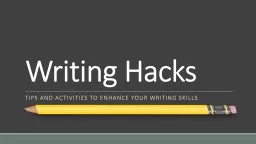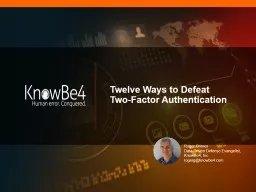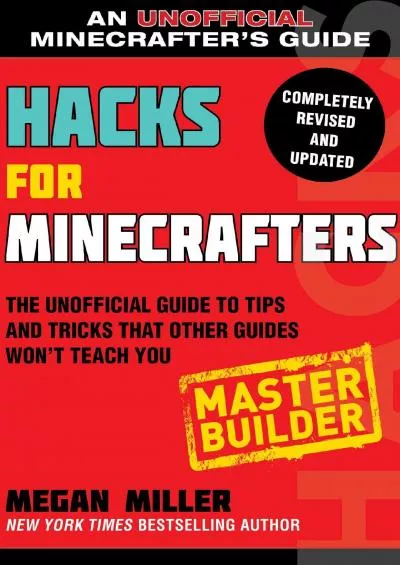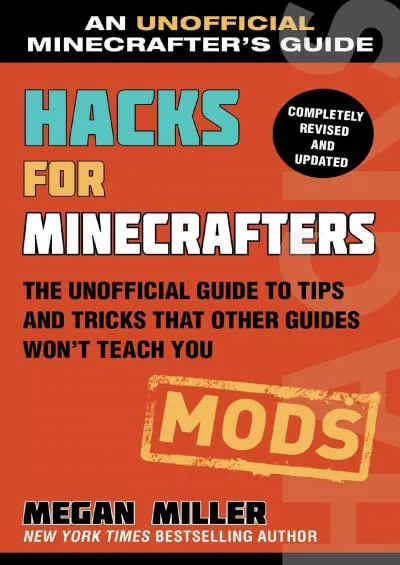PPT-Writing Hacks
Author : briana-ranney | Published Date : 2017-05-28
Tips and activities to enhance your writing skills FPMA 3 Results Hoverboards CLASS of LOW of MODERATE of HIGH Period 1 0 17 4 Period 2 5 10 5 Period 3 3 11 9
Presentation Embed Code
Download Presentation
Download Presentation The PPT/PDF document "Writing Hacks" is the property of its rightful owner. Permission is granted to download and print the materials on this website for personal, non-commercial use only, and to display it on your personal computer provided you do not modify the materials and that you retain all copyright notices contained in the materials. By downloading content from our website, you accept the terms of this agreement.
Writing Hacks: Transcript
Download Rules Of Document
"Writing Hacks"The content belongs to its owner. You may download and print it for personal use, without modification, and keep all copyright notices. By downloading, you agree to these terms.
Related Documents



![[DOWNLOAD] - 180 Days of Writing for Sixth Grade - An Easy-to-Use Sixth Grade Writing](https://thumbs.docslides.com/901243/download-180-days-of-writing-for-sixth-grade-an-easy-to-use-sixth-grade-writing-workbook-to-practice-and-improve-writing-skills.jpg)
![[EPUB] - Writing Fabulous Sentences & Paragraphs, Grades 4-6](https://thumbs.docslides.com/901378/epub-writing-fabulous-sentences-paragraphs-grades-4-6.jpg)
![[READ] - 180 Days of Writing for Fifth Grade - An Easy-to-Use Fifth Grade Writing Workbook](https://thumbs.docslides.com/901394/read-180-days-of-writing-for-fifth-grade-an-easy-to-use-fifth-grade-writing-workbook-to-practice-and-improve-writing-skills.jpg)
![[DOWNLOAD] - 180 Days of Writing for Kindergarten - An Easy-to-Use Kindergarten Writing](https://thumbs.docslides.com/901444/download-180-days-of-writing-for-kindergarten-an-easy-to-use-kindergarten-writing-workbook-to-practice-and-improve-writing-skills.jpg)
![[EBOOK] - Teaching Writing in Kindergarten: A Structured Approach to Daily Writing That](https://thumbs.docslides.com/901683/ebook-teaching-writing-in-kindergarten-a-structured-approach-to-daily-writing-that-helps-every-child-become-a-confident-capabl.jpg)
![[EBOOK] - Leadership Growth Hacks: A Guide for Emerging Leaders to Think Differently,](https://thumbs.docslides.com/902395/ebook-leadership-growth-hacks-a-guide-for-emerging-leaders-to-think-differently-kick-start-performance-and-get-ahead-quicker.jpg)
![[EPUB] - Businesspeople Don\'t Like to Read, We Scan: A Quick, Strategic Guide for Effective](https://thumbs.docslides.com/902899/epub-businesspeople-don-t-like-to-read-we-scan-a-quick-strategic-guide-for-effective-business-writing-speaking-and-writing.jpg)
![[EBOOK] - Ecologies of Writing Programs: Program Profiles in Context (Writing Program](https://thumbs.docslides.com/906283/ebook-ecologies-of-writing-programs-program-profiles-in-context-writing-program-adminstration.jpg)
![[EPUB] - Writing a Successful College Application Essay (Barron\'s Writing a Successful](https://thumbs.docslides.com/906666/epub-writing-a-successful-college-application-essay-barron-s-writing-a-successful-college-application-essay.jpg)


